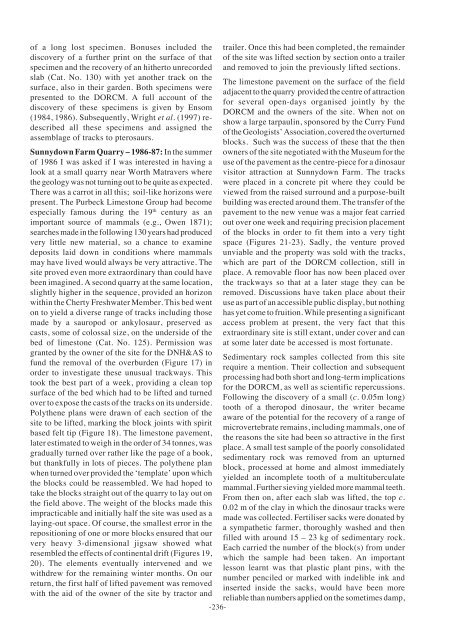Continental trace fossils and museum exhibits - Geological Curators ...
Continental trace fossils and museum exhibits - Geological Curators ...
Continental trace fossils and museum exhibits - Geological Curators ...
You also want an ePaper? Increase the reach of your titles
YUMPU automatically turns print PDFs into web optimized ePapers that Google loves.
of a long lost specimen. Bonuses included thediscovery of a further print on the surface of thatspecimen <strong>and</strong> the recovery of an hitherto unrecordedslab (Cat. No. 130) with yet another track on thesurface, also in their garden. Both specimens werepresented to the DORCM. A full account of thediscovery of these specimens is given by Ensom(1984, 1986). Subsequently, Wright et al. (1997) redescribedall these specimens <strong>and</strong> assigned theassemblage of tracks to pterosaurs.Sunnydown Farm Quarry – 1986-87: In the summerof 1986 I was asked if I was interested in having alook at a small quarry near Worth Matravers wherethe geology was not turning out to be quite as expected.There was a carrot in all this; soil-like horizons werepresent. The Purbeck Limestone Group had becomeespecially famous during the 19 th century as animportant source of mammals (e.g., Owen 1871);searches made in the following 130 years had producedvery little new material, so a chance to examinedeposits laid down in conditions where mammalsmay have lived would always be very attractive. Thesite proved even more extraordinary than could havebeen imagined. A second quarry at the same location,slightly higher in the sequence, provided an horizonwithin the Cherty Freshwater Member. This bed wenton to yield a diverse range of tracks including thosemade by a sauropod or ankylosaur, preserved ascasts, some of colossal size, on the underside of thebed of limestone (Cat. No. 125). Permission wasgranted by the owner of the site for the DNH&AS tofund the removal of the overburden (Figure 17) inorder to investigate these unusual trackways. Thistook the best part of a week, providing a clean topsurface of the bed which had to be lifted <strong>and</strong> turnedover to expose the casts of the tracks on its underside.Polythene plans were drawn of each section of thesite to be lifted, marking the block joints with spiritbased felt tip (Figure 18). The limestone pavement,later estimated to weigh in the order of 34 tonnes, wasgradually turned over rather like the page of a book,but thankfully in lots of pieces. The polythene planwhen turned over provided the ‘template’ upon whichthe blocks could be reassembled. We had hoped totake the blocks straight out of the quarry to lay out onthe field above. The weight of the blocks made thisimpracticable <strong>and</strong> initially half the site was used as alaying-out space. Of course, the smallest error in therepositioning of one or more blocks ensured that ourvery heavy 3-dimensional jigsaw showed whatresembled the effects of continental drift (Figures 19,20). The elements eventually intervened <strong>and</strong> wewithdrew for the remaining winter months. On ourreturn, the first half of lifted pavement was removedwith the aid of the owner of the site by tractor <strong>and</strong>trailer. Once this had been completed, the remainderof the site was lifted section by section onto a trailer<strong>and</strong> removed to join the previously lifted sections.The limestone pavement on the surface of the fieldadjacent to the quarry provided the centre of attractionfor several open-days organised jointly by theDORCM <strong>and</strong> the owners of the site. When not onshow a large tarpaulin, sponsored by the Curry Fundof the Geologists’ Association, covered the overturnedblocks. Such was the success of these that the thenowners of the site negotiated with the Museum for theuse of the pavement as the centre-piece for a dinosaurvisitor attraction at Sunnydown Farm. The trackswere placed in a concrete pit where they could beviewed from the raised surround <strong>and</strong> a purpose-builtbuilding was erected around them. The transfer of thepavement to the new venue was a major feat carriedout over one week <strong>and</strong> requiring precision placementof the blocks in order to fit them into a very tightspace (Figures 21-23). Sadly, the venture provedunviable <strong>and</strong> the property was sold with the tracks,which are part of the DORCM collection, still inplace. A removable floor has now been placed overthe trackways so that at a later stage they can beremoved. Discussions have taken place about theiruse as part of an accessible public display, but nothinghas yet come to fruition. While presenting a significantaccess problem at present, the very fact that thisextraordinary site is still extant, under cover <strong>and</strong> canat some later date be accessed is most fortunate.Sedimentary rock samples collected from this siterequire a mention. Their collection <strong>and</strong> subsequentprocessing had both short <strong>and</strong> long-term implicationsfor the DORCM, as well as scientific repercussions.Following the discovery of a small (c. 0.05m long)tooth of a theropod dinosaur, the writer becameaware of the potential for the recovery of a range ofmicrovertebrate remains, including mammals, one ofthe reasons the site had been so attractive in the firstplace. A small test sample of the poorly consolidatedsedimentary rock was removed from an upturnedblock, processed at home <strong>and</strong> almost immediatelyyielded an incomplete tooth of a multituberculatemammal. Further sieving yielded more mammal teeth.From then on, after each slab was lifted, the top c.0.02 m of the clay in which the dinosaur tracks weremade was collected. Fertiliser sacks were donated bya sympathetic farmer, thoroughly washed <strong>and</strong> thenfilled with around 15 – 23 kg of sedimentary rock.Each carried the number of the block(s) from underwhich the sample had been taken. An importantlesson learnt was that plastic plant pins, with thenumber penciled or marked with indelible ink <strong>and</strong>inserted inside the sacks, would have been morereliable than numbers applied on the sometimes damp,-236-
















